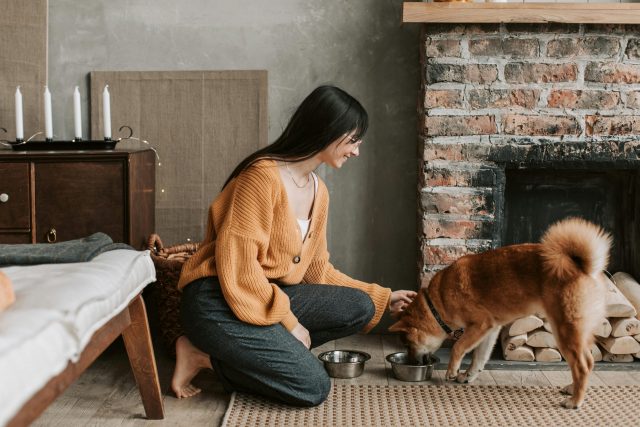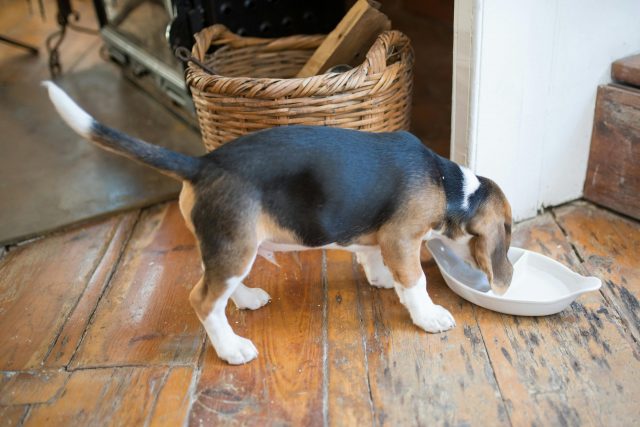Food aggression in dogs is a concerning behavior that can pose significant risks to the dog and its owners. Understanding how to handle a dog with food aggression is crucial for ensuring safety and promoting a harmonious living environment. Food aggression, a form of resource guarding, manifests as aggressive behaviors when a dog eats or around food. These behaviors can include growling, snapping, or even biting. Addressing this issue protects family members and other pets and improves the dog’s overall well-being.
This article delves into the causes, assessment, and management of food aggression in dogs, providing practical strategies to tackle this behavior effectively.

Understanding Food Aggression in Dogs
Food aggression in dogs is characterized by defensive behaviors when eating or guarding their food. Common signs include growling, snapping, barking, or biting when someone approaches the dog during mealtime. Several factors can contribute to food aggression, such as a history of competition for food, inadequate socialization, past trauma, or underlying anxiety. Understanding these potential causes is essential for developing effective strategies to handle a dog with food aggression.
Learn Which Breeds Are Likely To Steal Your Meals
Assessing the Severity of Food Aggression
Before addressing food aggression, it’s important to assess its severity. Food aggression can range from mild to severe:
- Mild Food Aggression: Dogs might growl or stiffen when approached during meals but do not attempt to bite.
- Moderate Food Aggression: Dogs might snap or lunge when someone comes near their food bowl.
- Severe Food Aggression: Dogs might bite or attack to protect their food, posing a significant safety risk.
Evaluating the severity of your dog’s food aggression helps you choose the appropriate management and training techniques. It also determines whether professional intervention is needed.
Preventive Measures to Avoid Food Aggression
Preventing food aggression from developing is the best approach. Early socialization and training play crucial roles in this process. Here are some strategies:
- Socialization: Expose puppies to various situations and people to make them comfortable with different environments.
- Positive Reinforcement: Reward calm behavior around food to create positive associations.
- Feeding Routine: Establish a consistent feeding routine to prevent anxiety around mealtime.
- Avoid Punishment: Never punish a dog for food aggression, as this can worsen the behavior.
These preventive measures can help reduce the risk of developing food aggression in puppies and adult dogs.
Find Out Which Dog Breeds Are The Most Well-Mannered
Steps to Handle a Dog with Food Aggression
Handling a dog with food aggression requires patience and consistency. Here’s a step-by-step guide:
- Desensitization: Gradually expose your dog to people near their food without causing stress. Start by standing at a distance and slowly move closer over time.
- Counter-Conditioning: Teach your dog to associate people approaching their food with positive outcomes. For example, approach the dog while eating and tossing a high-value treat, gradually decreasing the distance.
- Controlled Feeding: Feed your dog in a controlled environment where they feel safe and unthreatened.
- Hand-Feeding: Feed your dog by hand to build trust and reduce aggression.
Following these steps can help your dog become more comfortable and less aggressive around food.
Training Techniques to Reduce Food Aggression
Specific training exercises can effectively reduce food aggression. Here are some techniques:
- Trade-Up Game: Offer your dog a higher-value item in exchange for their food, teaching them that giving up food leads to better rewards.
- Sit and Wait: Teach your dog to sit and wait calmly before eating, reinforcing good behavior.
- Gradual Exposure: Slowly introduce your dog to different scenarios involving food to reduce their anxiety and aggressive reactions.
Positive reinforcement is key in all training methods; consistently reward non-aggressive behavior to encourage calmness and trust.
When to Seek Professional Help
In some cases, professional help may be necessary to handle severe food aggression. If your dog’s aggression poses a safety risk or you can’t progress with training, consult a professional dog trainer or behaviorist. Look for professionals with experience in dealing with food aggression and positive reinforcement techniques. A qualified expert can provide tailored guidance and support, ensuring your and your dog’s safety and well-being.
Personal Stories and Testimonials
Hearing from other dog owners who have successfully managed food aggression can be encouraging. For example, one owner might share how desensitization and counter-conditioning transformed their dog’s behavior, leading to peaceful mealtimes. Another might describe the positive impact of professional training on their dog’s food aggression. These personal stories highlight the effectiveness of various strategies and the possible positive outcomes.
Discover The Dogs That Will Eat Anything
Conclusion: How to Handle a Dog with Food Aggression
In conclusion, understanding how to handle a dog with food aggression is essential for ensuring safety and fostering a harmonious home environment. You can manage and reduce food aggression in your dog by assessing the severity, implementing preventive measures, and using effective training techniques. Patience and consistency are key; seeking professional help when necessary can make a significant difference. With the right approach, you can help your dog overcome food aggression and enjoy a peaceful mealtime routine, enhancing their quality of life and yours.

 Toledo, United States.
Toledo, United States.